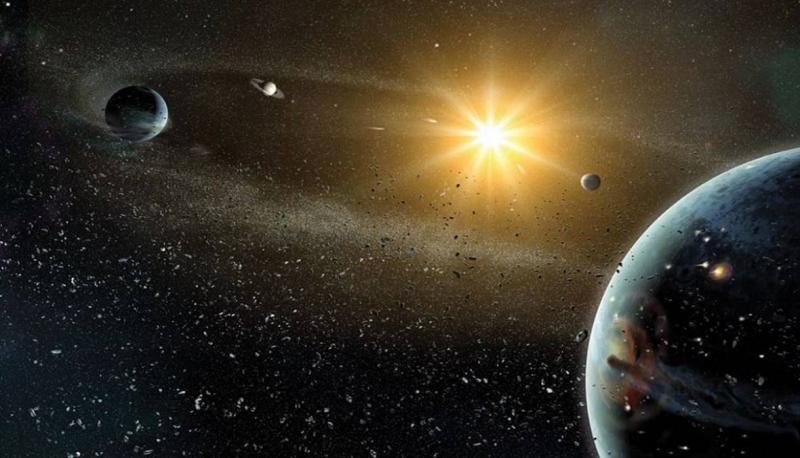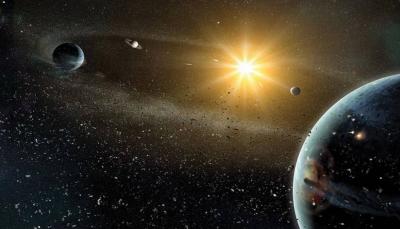Our solar system, including Earth, is not only vulnerable to meteorite impacts. There are possibilities that our solar system could experience disruption, if not destruction, if a rogue star passes too close. But what are rogue stars? Why might they move towards our solar system among all the other systems in the Milky Way galaxy? And most importantly, what are the chances of this happening?
According to "Universe Today", stars are bound to their galaxies by gravitational forces and move in coordination with their surroundings. However, sometimes something breaks that connection. For instance, if a star gets too close to a supermassive black hole, the black hole can eject it into space as a rogue star.
**At Its Mercy**
After several billion years, our solar system has evolved into a predictably stable system. The planets move as the solar system moves, with the sun remaining relatively stationary amidst it all. But if another star comes too close, the invisible gravitational ties that keep everything in place may stretch or break. Earth is a small planet, comprising only three millionths of the sun’s mass. If another star were to intrude into our orderly system, Earth would be at the mercy of the new gravitational standard.
A recent paper discusses what could happen if a rogue star approaches within 100 astronomical units of the sun (one astronomical unit is about 150 million km). The title of the paper is "Future Paths of the Solar System: Dynamic Simulations of Star Encounters Within 100 Astronomical Units". It will be published in the "Monthly Notices of the Royal Astronomical Society". The lead author is Sean Raymond, an astronomer at the Astrophysical Laboratory at Purdue, a joint research unit between the "National Center for Scientific Research" and Purdue University.
The report continues that the stable predictability of our solar system won’t last. The sun will continue to evolve and become brighter over the next billion years. Earth will come very close to the inner edge of the habitable zone. Just getting a little closer to the sun could disrupt the delicate balance that allows liquid water to remain on the surface.
Within the same billion-year timeframe, there is about a 1% chance of encountering a rogue star.
**The System Will Not Remain Closed**
The authors write, "Earth has about a billion years of surface conditions suitable for habitability." This is in a closed system, which is mostly what our solar system is. If a passing star arrives, our solar system would not remain closed. Most rogue stars, also referred to as intergalactic stars or hypervelocity stars because their paths take them out of the Milky Way, do not approach Earth. For example, Kappa Cassiopeiae is 4000 light-years away and will never get close. Others, like the 675 rogue stars discovered by astronomers at Vanderbilt University in 2012, were ejected after interacting with the Milky Way’s massive black hole, and their paths have not brought them near Earth.
Even in the Milky Way galaxy, space is mostly empty, and most stellar flybys will never approach another solar system. Researchers explain: "Statistically, a flyby at less than 100 astronomical units, which would significantly impact planetary orbits, occurs only about once every 100 billion years in the current galactic neighborhood."
Although the odds are low, it remains a possibility.
**12,000 Simulations**
The team began with the eight planets of the solar system and added one rogue star. They matched the masses of the simulated rogue stars to the masses of stars in our stellar neighborhood. They also matched the velocities of the rogue stars in the vicinity. They simulated different speeds and trajectories for the star to see how it would affect Earth. In total, the researchers conducted 12,000 simulations.
The authors wrote: "If a star passes within 100 astronomical units of the sun, there is still a very high chance that all eight planets of the solar system will survive." There is over a 95% chance that no planets will be lost.
But what does it look like when one of our solar system’s planets is lost?
The simulations produced a variety of outcomes. Mercury is the most at risk and occasionally gets lost when it collides with the sun. Other results include Earth colliding with Venus, the ice giants Uranus and Neptune being ejected, and the survival of only Earth and Jupiter, or only Jupiter. In one shocking result, all eight planets were ejected.
Other results are less dramatic. All eight planets either remain undisturbed, slightly disturbed, or severely disturbed.
**Details of the Probabilities**
While the eight planets survived in most simulations, survival can mean different things. Their orbits could be significantly disturbed. Some planets could be pushed into the Oort Cloud (which lies at the outer reaches of the solar system and is the primary source of long-period comets made up of icy bodies).
The researchers also cataloged the ten most likely outcomes where planets would be destroyed. They wrote: "We have identified the most common paths through which planets can be lost, while taking into account that there is a greater than or equal to 95% chance of not losing any planet if a star passes within 100 astronomical units."
- Mercury colliding with the sun (2.54% probability)
- Mars colliding with the sun (1.21%)
- Venus colliding with another planet (1.17%)
- Ejection of Uranus (1.06%)
- Ejection of Neptune (0.81%)
- Mercury impacting another planet (0.8%)
- Earth colliding with another planet (0.48%)
- Ejection of Saturn (0.32%)
- Collision of Mars with another planet (0.27%)
- Earth colliding with the sun (0.24%)
When it comes to ejections, Uranus and Neptune face the worst probabilities. This is not surprising given their distance from the sun and their weaker gravitational ties. It’s also not surprising that Mercury has the highest chances of colliding with the sun. As the least massive planet, it faces a greater risk of disruption due to a nearby flyby star.
**Devastating Annihilation**
When it comes to Earth, there exists a wide range of potential outcomes. In the list above, Earth has a 0.48% chance of colliding with another planet. However, another possible fate for Earth, which is not pleasant to think about, is being expelled into the Oort Cloud.
The authors stated, "Earth’s long-term survival in the Oort Cloud is not guaranteed."
Another strange outcome from the simulations deserves consideration: a rogue star capturing Earth. There was a simulation containing a star slightly less massive than the sun that was moving at a relatively slow speed and approached our solar system. The result was devastating annihilation of the solar system as we know it. Earth abandoned the sun and ran away with the star, while six other planets collided with the sun. The only planet that survived was Jupiter, as it is the most massive planet.
The paper outlines a wide range of outcomes, including the collision of the moon with Earth, capturing of the rogue star with Earth and the moon, and even the destruction of all planets and their moons. However, the probabilities of any of this occurring are exceedingly small.
But how likely is it that Earth remains habitable in such an encounter? If Earth’s orbit changes, the planet will become either hotter or colder as a result.
There are other potential fates. Earth could survive as a rogue planet for about a million years until its surface freezes. Or, perhaps if captured by the rogue star, it might remain habitable in some new arrangement.
**Conclusion**
Ultimately, the chances of a star flying by within 100 astronomical units are extremely slim. The simulations show that if this happens, the most likely outcome is that all eight planets survive, albeit with slightly different orbits than they currently follow. The researchers concluded, "Despite the variety of potential evolutionary paths, there is a strong chance that the current state of our solar system will not change."




